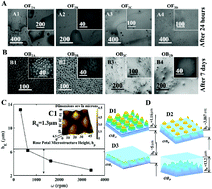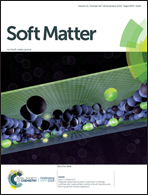Tunable adhesion and slip on a bio-mimetic sticky soft surface†
Abstract
Simultaneous tuning of wettability and adhesion of a surface requires intricate procedures for altering the interfacial structures. Here, we present a simple method for preparing a stable slippery surface, with an intrinsic capability of varying its adhesion characteristics. Cross-linked PDMS, an inherent hydrophobic material commonly used for microfluidic applications, is used to replicate the structures on the surface of a rose petal which acts as a high adhesion solid base and is subsequently oleoplaned with silicone oil. Our results demonstrate that the complex hierarchical rose petal structures can arrest dewetting of the silicone oil on the cross linked PDMS base by anchoring the oil film strongly even under flow. Further, by tuning the extent of submergence of the rose petal structures with silicone oil, we could alter the adhesion characteristics of the surface on demand, while retaining its slippery characteristics for a wide range of the pertinent parameters. We have also demonstrated the possible fabrication of gradient adhesion surfaces. This, in turn, may find a wide variety of applications in water harvesting, droplet maneuverability and no-loss transportation in resource-limited settings.



 Please wait while we load your content...
Please wait while we load your content...